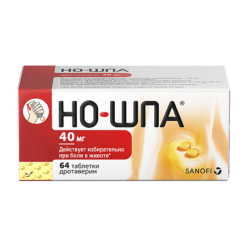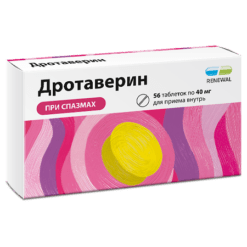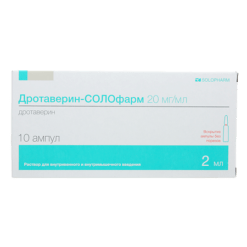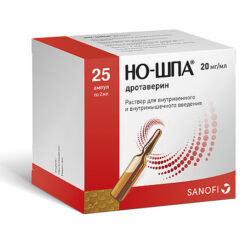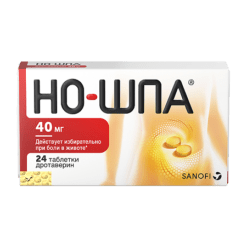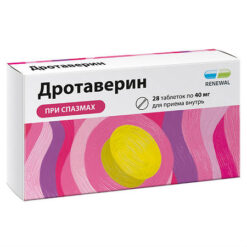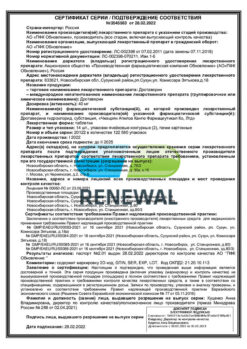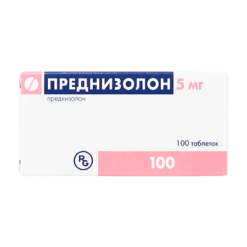No products in the cart.
Drotaverine, tablets 40 mg 50 pcs
€4.60 €3.83
Description
Spasmolytics
ATH code
A03AD02
Pharmacodynamics:
Drotaverine is a myotropic antispasmodic. Isoquinoline derivative with chemical structure and pharmacological properties similar to papaverine but with stronger and longer action.
Drotaverine has a powerful antispasmodic effect on smooth muscles by inhibiting the enzyme phosphodiesterase 4 (PDE-4). The enzyme FDE-4 is required for hydrolysis of cAMP to AMP. Inhibition of the enzyme FDE-4 leads to an increase in the concentration of cAMP, which triggers the following cascade reaction: high concentrations of cAMP activate cAMP-dependent phosphorylation of myosin light chain kinase (MLCK or MLCK). Phosphorylation of CLSM leads to a decrease in its affinity for the Ca2+-calmodulin complex, resulting in the inactivated form of CLSM maintaining muscle relaxation.
In addition, cAMP affects the cytosolic concentration of Ca2+ ion by stimulating Ca2+ transport into the extracellular space and the sarcoplasmic reticulum. This effect of drotaverine on lowering the cytosolic concentration of Ca2+ ion through cAMP explains its antagonistic effect toward Ca2+.
In vivorotaverine inhibits the FDE-4 isoenzyme without inhibiting the FDE-3 and FDE-5 isoenzymes. Therefore, the effectiveness of drotaverine depends on the concentrations of FDE-4 in tissues, the content of which varies in different tissues. FDE-4 is most important for inhibition of contractile activity of smooth muscles and therefore selective inhibition of FDE-4 may be useful for treatment of hyperkinetic dyskinesia and various diseases accompanied by spastic state of the gastrointestinal tract (GIT).
The hydrolysis of CAMP in the myocardium and vascular smooth muscle occurs mainly via the FDE-3 isoenzyme, which explains the fact that with high spasmolytic activity drotaverine has no serious cardiovascular side effects and pronounced effects on the cardiovascular system.
Drotaverine effectively relieves smooth muscle spasms of nervous and muscular etiology. Regardless of the type of autonomic innervation, drotaverine relaxes the smooth muscles of the gastrointestinal tract biliary vasculature.
Because of its vasodilator effect, drotaverine improves blood supply to tissues. It does not affect the autonomic nervous system does not penetrate into the central nervous system (CNS). Its direct effect on the smooth muscles allows drotaverine to be used as an antispasmodic when drugs from the group of m-cholinoblockers are contraindicated (closed-angle glaucoma, prostate hypertrophy).
Pharmacokinetics:
In comparison with papaverine, drotaverine when taken orally is faster and more completely absorbed from the gastrointestinal tract. Bioavailability is about 100%. The half-absorption period is 12 minutes.
But after metabolism during “first passage through the liver” 65% of the dose taken enters the systemic bloodstream. The maximum plasma concentration (Cmax) is reached within 45-60 minutes.
In vitro drotaverine has high binding to plasma proteins (95-97%) especially to γ- and β-globulin albumin.
Drotaverine is evenly distributed in tissues penetrates smooth muscle cells. It does not penetrate the blood-brain barrier. Drotaverine and/or its metabolites may slightly penetrate through the placental barrier.
Drotaverine is almost completely metabolized in the liver by O-desethylation. Its metabolites rapidly conjugate to glucuronic acid. The main metabolite is 4′-dezethyldrotaverine in addition to which 6-dezethyldrotaverine and 4-dezethyldrotaveraldine have been identified.
The half-life (T1/2) of drotaverine is 8-10 hours.
In 72 hours drotaverine is almost completely eliminated from the body more than 50% of the drug is eliminated by the kidneys (mostly as metabolites) and about 30% through the gastrointestinal tract (excretion into the bile). Unchanged drotaverine is not detected in the urine.
Indications
Indications
– Smooth muscle spasms in diseases of the biliary tract: cholecystolithiasis, cholangiolithiasis, cholecystitis, pericholecystitis, cholangitis, inflammation of the duodenal papilla (papillitis);
– spasms of smooth muscles in diseases of the urinary tract: nephrolithiasis, urethrolithiasis, pyelitis, cystitis, bladder spasms.
As an adjuvant therapy:
– for spasms of smooth muscles of the gastrointestinal tract: peptic ulcer of the stomach and duodenum, gastritis, spasms of the cardia and pylorus, enteritis, colitis, spastic colitis, accompanied by constipation and irritable bowel syndrome with flatulence;
– for tensor headaches (tension headaches);
– with algodismenorrhea.
Pharmacological effect
Pharmacological effect
Antispasmodic
ATX code
A03AD02
Pharmacodynamics:
Drotaverine is a myotropic antispasmodic. The isoquinoline derivative is similar in chemical structure and pharmacological properties to papaverine but has a stronger and longer-lasting effect.
Drotaverine has a powerful antispasmodic effect on smooth muscle due to inhibition of the enzyme phosphodiesterase 4 (PDE-4). The enzyme PDE-4 is necessary for the hydrolysis of cAMP to AMP. Inhibition of the PDE-4 enzyme leads to an increase in cAMP concentrations, which triggers the following cascade reaction: high concentrations of cAMP activate cAMP-dependent phosphorylation of myosin light chain kinase (MLCK or MLCK). Phosphorylation of MLCK leads to a decrease in its affinity for the Ca2+-calmodulin complex, resulting in an inactivated form of MLCK supporting muscle relaxation.
In addition, cAMP affects the cytosolic concentration of Ca2+ ion by stimulating the transport of Ca2+ into the extracellular space and the sarcoplasmic reticulum. This effect of drotaverine in lowering the cytosolic concentration of Ca2+ ion through cAMP explains its antagonistic effect towards Ca2+.
In vitro, drotaverine inhibits the PDE-4 isoenzyme without inhibiting the PDE-3 and PDE-5 isoenzymes. Therefore, the effectiveness of drotaverine depends on the concentrations of PDE-4 in tissues, the content of which varies in different tissues. PDE-4 is most important for suppressing the contractile activity of smooth muscles, and therefore selective inhibition of PDE-4 may be useful for the treatment of hyperkinetic dyskinesias and various diseases accompanied by a spastic state of the gastrointestinal tract (GIT).
The hydrolysis of cAMP in the myocardium and vascular smooth muscle occurs mainly with the help of the PDE-3 isoenzyme, which explains the fact that with high antispasmodic activity, drotaverine has no serious side effects on the heart and blood vessels and no pronounced effects on the cardiovascular system.
Drotaverine effectively eliminates smooth muscle spasms of nervous and muscular etiology. Regardless of the type of autonomic innervation, drotaverine relaxes the smooth muscles of the gastrointestinal tract of the biliary tract of the genitourinary vascular system.
Due to its vasodilating effect, drotaverine improves blood supply to tissues. Does not affect the autonomic nervous system and does not penetrate the central nervous system (CNS). The presence of a direct effect on smooth muscles allows the use of drotaverine as an antispasmodic in cases where drugs from the group of m-anticholinergics are contraindicated (angle-closure glaucoma, prostatic hypertrophy).
Pharmacokinetics:
Compared with papaverine, drotaverine, when taken orally, is absorbed faster and more completely from the gastrointestinal tract. Bioavailability is about 100%. The half-absorption period is 12 minutes.
However, after metabolism during the “first pass through the liver,” 65% of the dose taken enters the systemic circulation. Maximum plasma concentration (Cmax) is achieved within 45-60 minutes.
In vitro, drotaverine has a high binding to plasma proteins (95-97%), especially with albumin γ- and β-globulins.
Drotaverine is evenly distributed throughout the tissues and penetrates smooth muscle cells. Does not penetrate the blood-brain barrier. Drotaverine and/or its metabolites may slightly penetrate the placental barrier.
Drotaverine is almost completely metabolized in the liver by O-desethylation. Its metabolites quickly conjugate with glucuronic acid. The main metabolite is 4′-desethyldrotaverine, in addition to which 6-desethyldrotaverine and 4-desethyldrotaveraldine have been identified.
The half-life (T1/2) of drotaverine is 8-10 hours.
Within 72 hours, drotaverine is almost completely eliminated from the body; more than 50% of the drug is excreted by the kidneys (mainly in the form of metabolites) and about 30% through the gastrointestinal tract (excretion into bile). Unchanged drotaverine is not detected in urine.
Special instructions
Special instructions
The use of the drug for arterial hypotension requires increased caution.
Each tablet contains 6645 mg of lactose monohydrate, which may cause gastrointestinal problems in patients with lactose intolerance. This form of the drug is unacceptable for patients with lactase deficiency, galactosemia or glucose-galactose malabsorption syndrome (see section “Contraindications”).
Impact on the ability to drive vehicles. Wed and fur.:
When taken orally in therapeutic doses, drotaverine does not affect the ability to drive vehicles and perform work requiring increased concentration and speed of psychomotor reactions.
If any side effects occur, the question of driving or engaging in other potentially hazardous activities requires individual consideration.
If dizziness occurs, you should avoid engaging in potentially hazardous activities such as driving vehicles and operating machinery.
Active ingredient
Active ingredient
Drotaverine
Composition
Composition
For one tablet:
Active ingredient:
drotaverine hydrochloride – 40.0 mg.
Excipients:
povidone (low molecular weight medical polyvinylpyrrolidone 12600 ± 2700, plasdon K-17),
lactose monohydrate (milk sugar),
calcium stearate,
potato starch,
talc.
Pregnancy
Pregnancy
Drotaverine does not have a teratogenic or embryotoxic effect and does not have an adverse effect on the course of pregnancy. Despite this, when using the drug in pregnant women, caution should be exercised and the drug should be prescribed only after assessing the ratio of the expected benefit to the mother and the possible risk to the fetus.
Due to the lack of clinical data, the drug is not recommended for use during breastfeeding.
Contraindications
Contraindications
– Hypersensitivity to drotaverine and/or excipients included in the drug;
– severe liver or kidney failure;
– severe heart failure (low cardiac output syndrome);
– breastfeeding period;
– children under 6 years of age;
– hereditary lactose intolerance, lactase deficiency galactosemia or glucose-galactose malabsorption syndrome (due to the presence of lactose monohydrate in the composition of the drug).
With caution:
– For arterial hypotension;
– in children (insufficient clinical experience of use);
– in pregnant women (see section “Use during pregnancy and breastfeeding”);
– simultaneous use with levodopa (see section “Interaction with other drugs”).
Side Effects
Side Effects
The frequency of adverse reactions is given in accordance with the classification of the World Health Organization (WHO): very often – more than 1/10 often – more than 1/100 and less than 1/10 infrequently – more than 1/1000 and less than 1/100 rarely – more than 1/10000 and less than 1/1000 very rarely – less than 1/10000 including individual reports frequency unknown (determine the frequency of occurrence According to available data, it is impossible).
From the nervous system: rarely – headache, dizziness, insomnia.
From the cardiovascular system: rarely – palpitations, decreased blood pressure.
From the gastrointestinal tract: rarely – nausea, constipation.
From the immune system: rarely – angioedema, urticaria, rash, itching; very rarely – anaphylactic shock (see section “Contraindications”).
Interaction
Interaction
With levodopa: when used simultaneously, drotaverine can weaken the antiparkinsonian effect of levodopa, that is, increase rigidity and tremor.
With papaverine bendazole and other antispasmodics (including m-anticholinergics): increased antispasmodic effect.
With morphine: reducing the spasmogenic activity of morphine.
With phenobarbital: enhancing the antispasmodic effect of drotaverine.
Overdose
Overdose
Symptoms of an overdose of drotaverine may include disturbances in heart rhythm and conduction (including complete block of the bundle branches) and cardiac arrest, including death.
Treatment: gastric lavage, symptomatic therapy.
Storage conditions
Storage conditions
In a place protected from light at a temperature not exceeding 25 ° C.
Keep out of the reach of children.
Shelf life
Shelf life
3 years.
Do not use after expiration date.
Manufacturer
Manufacturer
Ozon, Russia
Additional information
| Shelf life | 3 years. Do not use after the expiration date. |
|---|---|
| Conditions of storage | In the dark place at a temperature not exceeding 25 ° C. Store out of the reach of children. |
| Manufacturer | Ozon, Russia |
| Medication form | pills |
| Brand | Ozon |
Other forms…
Related products
Buy Drotaverine, tablets 40 mg 50 pcs with delivery to USA, UK, Europe and over 120 other countries.


